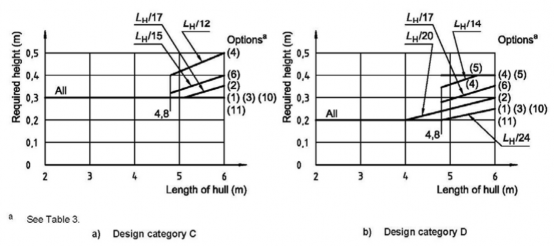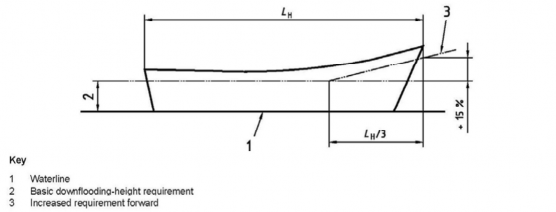

< Previous | Contents | Next >
Section 4 Crafts of Hull Length Less than 6 m
401. General
Non-sailing crafts shall be assessed using be assessed using 403. Habitable multihull
402. Sailing crafts other than habitable multihulls shall sailing crafts shall be assessed using Sec. 3.
402. Tests to be applied to non-sailing crafts
1. General
Non-sailing crafts may be assessed by anyone of six options according to length of hull, amount of
flotation and decking, and whether the craft is fitted with suitable recesses complying
ISO 11812. These options and the corresponding tests to be applied are given in
with KS V Table 5.8.
The design category finally given in respect of satisfies all the relevant requirements.
stability and buoyancy is that for which the craft
Table 5.8 Tests to be applied to non-sailing crafts
Option | 1(1) | 2 | 3(1) | 4 | 5 | 6(1) |
Applicable to length of hull | Up to 6.0 m | From 4.8 m up to 6.0 m | ||||
Design categories possible | C and D | C and D | D | C and D | D only | C and D |
Applicable to engine powers of | Any amount | Any amount | ≤ 3 kW | Any amount | Any amount | Any amount |
Applicable to the following types of engine installation | Any | Any | Any | Any | Any | Inboard engines only |
Decking or covering | Any amount | Fully decked | Any amount | Partially decked | Any amount | Any amount |
Downflooding-height test | 402. 2 (2) | 402. 2 | 402. 2 | 402. 2 | 402. 2 | 402. 2 |
Offset-load test | 402. 3 | 402. 3 | - | 402. 3 | 402. 3 | 402. 3 |
Flotation standard | Level | - | See 402. 6 | - | - | Basic |
Flotation test | 402. 4 | - | See 402. 6 | - | - | 402. 5 |
Flotation elements | Annex C (3) | - | Annex C (3) | - | - | Annex C (3) |
Capsize-recovery test | - | - | 402. 6 | - | - | - |
(NOTES) (1) Crafts using options 1, 3 and 6 are considered to be susceptible to swamping when used in their design category. (2) This test is not required to be applied if, when swamped during the test described in 402. 4, the craft supports an equivalent dry mass of 133 % of the maximum total load, or if the craft does nottakeon water when heeled to 90° from the upright in light craft condition. (3) See KS V ISO 12217-3 Annex C. | ||||||
![]()
2. Downflooding-height tests
Ch 5 Stability and buoyancy Ch 5
![]()
(1) Downflooding openings
To be in accordance with 202. 1 (1) (downflooding openings of Non-sailing crafts of hull length greater than or equal to 6 m)
(2) Test and requirements with maximum load
(A) Test
To be in accordance with 202. 1 (2) (test of downflooding height of Non-sailing crafts of hull length greater than or equal to 6 m)
(B) Requirements
(a) Determine the design category by comparing the measurements with the requirements for minimum downflooding height, as modified by (b) to (f) below, using either
(i) the method of normative KS V ISO 12217-3 Annex A, which generally gives the
lowest requirement, or
(ii) Fig 5.10 which is based only on craft length.
(b) For crafts assessed using options 1, 3, 5 or 6, the required downflooding height within
ÄĂ ĤĖ of the bow shall be increased as shown in Fig 5.11.
(c)
Crafts assessed using options 1 or 3 are permitted a 20 % reduction in required down-
flooding height in the way of an outboard engine mounting position, provided that the
width of this reduction is minimized.
(d) The required downflooding height at the transom shall be reduced by 0.05 m for crafts of design category C using option 1, provided that such crafts have a watertight recess aft (i.e.: cockpit).
(e) Crafts assessed using Fig 5.10 shall be permitted downflooding openings having a com-
bined clear area, expressed in square millimetres (mmË),
Ë
of not more than (ÈŊÄĂ ) with-
in the aft quarter of
less than 3/4 of that
ÄĂ provided that the downflooding required by Fig 5.10.
height
to these openings is not
(f) For sailing crafts also equipped for use as non-sailing crafts, the required downflooding
height for centreboard, drop keel or dagger-board casings shall be half by (a) above.
that determined

Fig 5.10 Required downflooding height - Design categories C and D
(3) Outboard crafts when starting
In addition and only applicable to crafts with provision for externally mounted outboard en- gine(s), the following requirements shall be satisfied,
(A) When the craft is in the light craft condition, with engine(s) fitted and one person of not
less than 75 kg positioned 0,5 m forward of the engine attachment point, the least height from the waterline to the point at which the craft could first begin to enter any down- flooding opening shall be greater than 0,1 m.
(B) The mass of petrol engines shall be taken from columns 1 and 3 of KS V ISO 12217-3
of Tables B.1 and B.2 as appropriate to the maximum power recommended for the craft by
![]()
the builder. For other engines, the mass of the actual engine shall be used.
Ch 5 Stability and buoyancy Ch 5
![]()
3. Offset-load tests
This test is to demonstrate sufficient stability against offset loading by the crew, for unswamped crafts. Details are to be in accordance with KS V ISO 12217-3.

Fig 5.11 Increase in required downflooding height - Options 1, 3, 5 and 6 (see Table 5.8)
4. Level flotation test
This test is to demonstrate adequate swamped buoyancy and stability. Details are to be in accordance with KS V ISO 12217-3.
5. Basic flotation test
This test is to demonstrate that the craft has sufficient flotation to satisfy the swamped buoyancy load test. Details are to be in accordance with KS V ISO 12217-3.
6. Capsize-recovery test
This test is to demonstrate that a capsized craft can be returned to the upright by the actions of the crew using their body action and/or righting devices purposely designed and permanently fitted to the craft, that it will subsequently float, and to verify that the recommended minimum crew mass is sufficient for the recovery method used. Details are to be in accordance with KS V ISO 12217- 3.
403. Tests to be applied to sailing crafts
1. General
Sailing crafts other than habitable multihulls may be assessed by anyone of five options according to amount of flotation and decking. These options and the tests to be applied are given in Table
5.9. Habitable multihull sailing crafts shall be assessed using KS V ISO 12217-2.
If a sailing craft is also equipped for use as a non-sailing craft, e.g. for rowing or for engine pro- pulsion, it shall also meet the requirements for non-sailing crafts.
The design category finally given in respect of stability and buoyancy is that for which the craft satisfies all the relevant requirements.
2. Downflooding-height tests
The downflooding-height testing or by calculation.
3. Flotation tests
(1) Level flotation test The purpose of the
tests shall be conducted in accordance with 402. 2, either by practical
level flotation test is to demonstrate adequate swamped buoyancy and
Ch 5 Stability and buoyancy Ch 5
![]()
stability. Details are to be in accordance with KS V ISO 12217-3.
(2) Basic flotation test
The purpose of the basic flotation test is to demonstrate that the craft has sufficient swamped buoyancy. Details are to be in accordance with KS V ISO 12217-3.
Table 5.9 Tests to be applied to sailing crafts
Option | 7(1) | 8(1) | 9(1) | 10 | 11 |
Categories possible | C and D | C and D | C and D | C and D | C and D |
Applicable to hull types | All | Monohull only | Monohull only | All | All |
Decking or covering | Any amount | Any amount | Any amount | Fully decked | Fully decked |
Downflooding-height test | - | - | - | 403. 2 | 403. 2 |
Flotation standard | - | Level (Cat C) Basic (Cat D) | Level (Cat C)(2) Basic (Cat D)(2) | - | - |
Flotation test | - | 403. 3 | 403. 3(2) | - | - |
Flotation elements | Annex C(3) | Annex C(3) | Annex C(3) | - | - |
Capsize-recovery test | 403. 4 | - | - | - | - |
Knockdown-recovery test | - | 403. 5 | - | 403. 5 | - |
Wind stiffness test | - | - | 403. 6 | - | 403. 6 |
Note : (1) Crafts using options 7, 8 and 9 are considered to be susceptible to swamping when used in their design cat- egory, excepting those crafts using option9 and covered by the exemptions given in footnote b. (2) Flotation testing is not requiredfor crafts satisfying the exemptions given in 403. 3 (1) or (2). (3) See KS V ISO 12217-3 Annex C. | |||||
4. Capsize-recovery test
(1) The capsize-recovery test shall be conducted following additional preparations:
(A) fore-and-aft sails shall be hoisted and set;
(B) centreboard(s) or keel(s) shall be lowered.
in accordance with 402. 6 (1) to (9), with the
(2) Crafts passing the above test shall be given either design category C or D at the discretion of
the builder, and shall be permanently marked in a prominent position with the symbols shown in Fig 5.12.

Fig 5.12 Warning symbols
5. Knockdown-recovery test
![]()
This test is to demonstrate that a craft can return to the upright unaided after being knocked down. Details are to be in accordance with KS V ISO 12217-3.
Ch 5 Stability and buoyancy Ch 5
![]()
6. Wind stiffness test
This test is to demonstrate that, when a sailing craft is heeled to a steady wind speed appropriate to the design category, the craft does not start flooding. Details are to be in accordance with KS V ISO 12217-3.